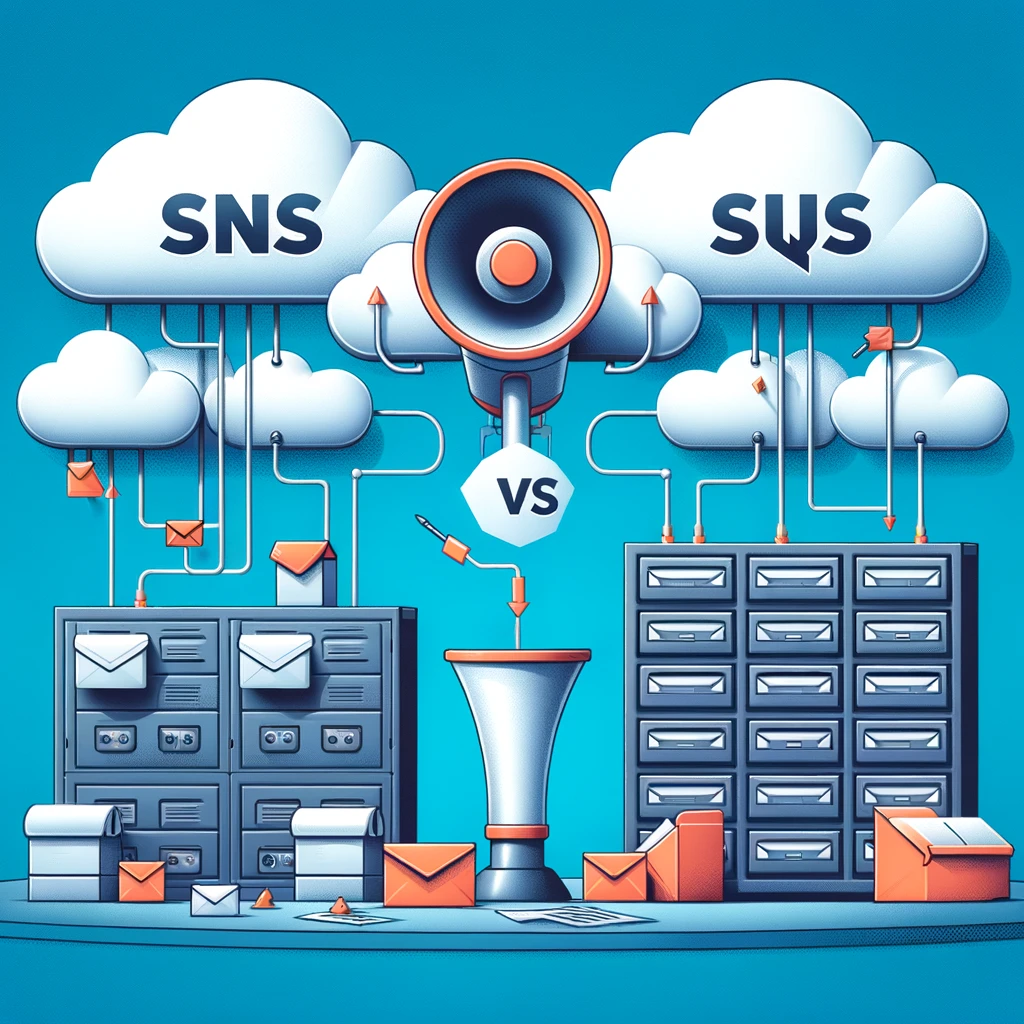When embarking on the journey of cloud services, particularly within AWS, two critical services often come up for discussion: Simple Notification Service (SNS) and Simple Queue Service (SQS). Both play pivotal roles in message orchestration but serve different purposes.
What Are SNS and SQS?
AWS SNS, a fully managed pub/sub messaging service, excels in scenarios requiring real-time notifications. It is designed to quickly distribute messages to a wide range of subscribers, including both applications (Application-to-Application or A2A) and end-users (Application-to-Person or A2P), through various channels like email, SMS, and push notifications. The strength of SNS lies in its ability to facilitate immediate, push-based communication without persisting messages, making it ideal for time-sensitive information dissemination.
On the other hand, AWS SQS offers a secure, durable, and available hosted queue that lets you integrate and decouple distributed software systems and components. SQS supports at-least-once message delivery, ensuring that no message is lost and allowing for the processing of messages in a flexible manner. Messages in SQS can be persisted for a duration ranging from 1 minute to 14 days, providing a buffer that helps manage workload spikes without losing messages. This makes SQS more suited for scenarios where message processing can be deferred or needs to be distributed across multiple workers for scalability
While both services are powerful on their own, they can also be used together in some scenarios to leverage the benefits of both systems. For instance, using SNS topics to fan out messages to multiple SQS queues enables parallel processing of messages, thereby decoupling and scaling microservices, distributed systems, and serverless applications efficiently.
The choice between AWS SNS and SQS depends on the specific requirements of your application. SNS is your go-to for broadcasting real-time notifications to a wide audience quickly, whereas SQS is better suited for reliable, secure, and scalable message queuing for delayed processing. Understanding the key differences and use cases of these services is crucial for architecting robust, scalable, and efficient cloud-based applications. This introduction aims to provide a comprehensive overview of AWS SNS and SQS, highlighting their distinct features, use cases, and how they can be used together to build scalable and resilient applications.
The Technical Distinction
To delve deeper into the technical differences between AWS SNS and SQS, let’s consider their mechanisms and the implications for system design.
AWS SNS operates on a push-based model, which means that messages are actively sent or “pushed” to all the subscribers as soon as they are published. This immediate, proactive dissemination is useful when an event’s notification is time-sensitive, ensuring that all subscribers can react simultaneously. It’s particularly beneficial when you need to trigger multiple processes in response to a single event.
For instance, in an e-commerce scenario, as soon as a purchase is made, SNS can simultaneously notify inventory management to decrement stock, alert the billing service to invoice, and trigger an email confirmation to the customer. This concurrency is vital for maintaining real-time system responsiveness and is the hallmark of event-driven architectures.
AWS SQS, contrastingly, is based on a pull-based model, which relies on consumers to “poll” or check the queue for messages. This allows for messages to be processed in a controlled manner and at the pace that the consumer can handle. It’s the method of choice when the order of actions is critical, or when the workload needs to be regulated to prevent overloading the system.
For example, in processing transactions, an SQS queue could hold payment information until the fraud detection service is ready to evaluate it, thus preventing a bottleneck. It also allows for scaling as consumer processes can be added or removed according to the queue length, providing a mechanism for workload management.
To summarize, while SNS’s push model excels in immediate, wide-reaching notification, SQS’s pull model provides an orderly, manageable processing queue. The choice between them is not merely technical but strategic, depending on the nature and requirements of the tasks at hand.
A Practical Example: Credit Card Transactions
Imagine a user on an e-commerce site making a purchase. The moment they hit “buy,” a series of orchestrated events unfolds within the platform’s architecture, leveraging AWS’s SNS and SQS services.
Step 1: Transaction Initiation
A user’s purchase request is captured by a transaction processing web service. This service constructs a payload with transaction details such as the transaction ID, customer ID, email, and the amount charged.
Step 2: Credit Card Verification
The service then communicates with a Credit Card Authority Service—like Visa or MasterCard—to validate the transaction. Upon successful validation, the transaction is approved.
Step 3: Event Notification with SNS
This successful transaction is an event of interest to several components. Here, AWS SNS comes into play. The transaction details are published to an SNS topic, which acts like a loudspeaker announcing the event to various subscribed services.
Step 4: Diverse Service Actions
Various services are subscribed to this SNS topic, each with a different role. These include:
- Customer Reminder Service: A Lambda function that sends a “Thank You” email to the customer.
- Transaction Analytics Service: Hosted on EC2, this service pulls transaction data from an SQS queue. It’s responsible for updating daily order analytics and revenue calculations.
- Fraud Detection Service: Also, on EC2, this service polls a separate SQS queue, analyzing transactions for potential fraud.
Each service retrieves information from its SQS queue at its pace, processing the data independently. This decoupling allows for parallel processing and independent scaling, enhancing system reliability and performance.
In this workflow, AWS SNS and SQS demonstrate their unique capabilities. SNS quickly disseminates information to all interested services, while SQS queues allow for orderly and independent processing of events. This synergy is key in crafting a resilient and efficient cloud-based e-commerce architecture.
Choosing Between SNS and SQS
When deciding whether to use SNS or SQS, ask yourself:
- Do multiple systems need to know about an event immediately? If yes, SNS is your go-to.
- Does a single system need to process the information of an event on its own schedule? If so, SQS fits the bill.
By utilizing SNS, you can ensure that all interested parties are instantly informed. With SQS, you grant systems the autonomy to process messages without the risk of losing them.
For the DevOps and Cloud Architects
When designing your system’s architecture, considering SNS and SQS is essential for a robust, scalable, and fault-tolerant message-handling framework. These services allow you to decouple your microservices, leading to a more resilient system where failures in one component don’t cascade to others.
Amazon Web Services (AWS) offers two fundamental messaging services: Amazon Simple Notification Service (SNS) and Amazon Simple Queue Service (SQS). SNS is a publish-subscribe messaging service, ideal for applications that need real-time notifications. It supports multiple protocols for message delivery, including email, SMS, HTTP, Lambda functions, and more. On the other hand, SQS is a message queuing service that is more suited for message processing use cases. It can persist messages from 1 minute to 14 days, making it suitable for delayed communication and processing messages in parallel.
The choice between SNS and SQS depends on the specific requirements of your application. SNS is best for broadcasting real-time notifications to a wide audience quickly, while SQS is better suited for reliable, secure, and scalable message queuing for delayed processing. Understanding the key differences and use cases of these services is crucial for architecting robust, scalable, and efficient cloud-based applications.
Architecting the Future: SNS and SQS as Cornerstones
In the domain of cloud architecture, the significance of comprehending and harnessing the capabilities of AWS SNS and SQS cannot be overstated. Whether you find yourself disseminating messages to a broad audience using SNS or ensuring the dependable delivery of messages with SQS, both services form the bedrock of a responsive and effective cloud architecture.
As you venture into the intricacies of these services, it’s crucial to recognize that the selection between SNS and SQS extends beyond the technical domain; it also encapsulates the design philosophy of your system. The fundamental question arises: Do you require notification or queuing? This seemingly simple query serves as a guiding beacon, leading you to the appropriate service, thereby enabling your architecture to flourish in the dynamic realm of AWS.



